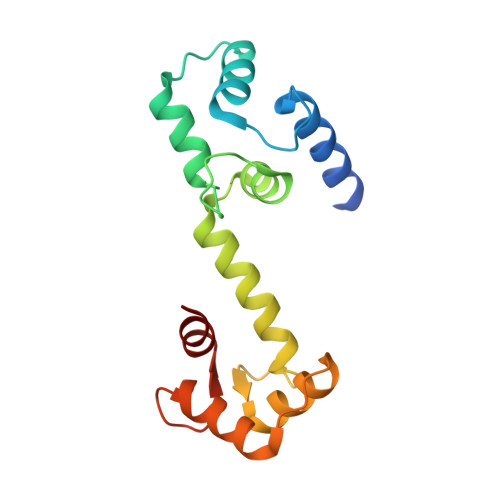Perturbation of the interactions of calmodulin with GRK5 using a natural product chemical probe.
Beyett, T.S., Fraley, A.E., Labudde, E., Patra, D., Coleman, R.C., Eguchi, A., Glukhova, A., Chen, Q., Williams, R.M., Koch, W.J., Sherman, D.H., Tesmer, J.J.G.(2019) Proc Natl Acad Sci U S A 116: 15895-15900
- PubMed: 31337679
- DOI: https://doi.org/10.1073/pnas.1818547116
- Primary Citation of Related Structures:
6EEB, 6O5G - PubMed Abstract:
G protein-coupled receptor (GPCR) kinases (GRKs) are responsible for initiating desensitization of activated GPCRs. GRK5 is potently inhibited by the calcium-sensing protein calmodulin (CaM), which leads to nuclear translocation of GRK5 and promotion of cardiac hypertrophy. Herein, we report the architecture of the Ca 2+ ·CaM-GRK5 complex determined by small-angle X-ray scattering and negative-stain electron microscopy. Ca 2+ ·CaM binds primarily to the small lobe of the kinase domain of GRK5 near elements critical for receptor interaction and membrane association, thereby inhibiting receptor phosphorylation while activating the kinase for phosphorylation of soluble substrates. To define the role of each lobe of Ca 2+ ·CaM, we utilized the natural product malbrancheamide as a chemical probe to show that the C-terminal lobe of Ca 2+ ·CaM regulates membrane binding while the N-terminal lobe regulates receptor phosphorylation and kinase domain activation. In cells, malbrancheamide attenuated GRK5 nuclear translocation and effectively blocked the hypertrophic response, demonstrating the utility of this natural product and its derivatives in probing Ca 2+ ·CaM-dependent hypertrophy.
Organizational Affiliation:
Program in Chemical Biology, University of Michigan, Ann Arbor, MI 48109.

















